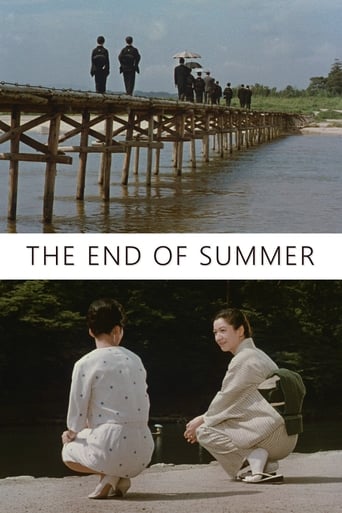treywillwest
Western viewers want to find a stoical impulse in Ozu's world view, but I think a certain orientalism is at play in this. Surely this "genius from the east" must be telling us something... transcendental and wise!
In fact, I think the two most constant themes in Ozu's films are the momentary joys of life, and the suffering that comes with the loss of loved ones, either to death, the demands of modernity, or some conspiracy between the two. Those two topics seem stripped particularly bare in this late work, a short one by the standards of the director. Ozu's longer films, particularly Tokyo Story, might literally be chamber dramas, but in their breadth of subject and number of characters they have an epic quality- a kaleidoscopic depiction of post-war Japanese society.
This film, by comparison, truly is a chamber drama with a relatively tight focus on one central figure and those around him. The characters aren't meant to comment about anything but themselves, and their joys and sorrows are laid all the more bare.
maryszd
This beautiful, haunting film takes place at the end of a hot Japanese summer that, as one of the characters puts it, "refuses to end." The mournful sound of cicadas accompanies the series of tableaux about the scion of the Namakura family, a whimsical widower who continues to see the mistress who caused his late wife and currently cause his three daughters a lot of sorrow. The film is about the impracticality and unpredictability of love in opposition to a rigid social order. Two of Namakura's daughters share their father's ambivalence about marriage. The older daughter, herself a widow, hesitates to re-marry. Although she embraces traditional values, she treasures her life "as it is," and values the freedom she now has as a single woman. Another daughter prefers to marry for love, rather than go with the dull, practical man her family has chosen for her. Only one daughter has a traditional marriage, but she's the most angry and outspoken to her father about his mistress. The film is also about the contrasts between the old and, "New Japan," the English words written on a flashing neon sign glimpsed on an anonymous city street. Despite his eccentricities, Namakura was a good businessman who kept the family sake business afloat; he could straddle both the old and new worlds. This is a physically gorgeous film, filled with humble domestic scenes that radiate the light of Vermeer and Dutch genre paintings. Ozu shows tremendous respect for women and the humble work they do--washing, sewing, cooking. It's work that is usually unseen and under-appreciated, so it's a pleasure to see it honored here.
Andres Salama
Ozu's penultimate film is also one of his best. As in many of his movies, the theme here deals with the dynamics of a traditional Japanese family. The aging patriarch of a family has to deal with marrying his two grown daughters (one is divorced with child, the great Setsuko Hara), the financial problems facing his small sake producing business, the reunion with his long lost lover and their capricious daughter and, last but not least, his impending death. The death theme hangs throughout the movie; Ozu was probably thinking of his own death when he filmed this (he would live only a couple of years more); the last shot has black crows standing over the patriarch's gravestone. Ozu's films in color are even better than those in black and white: his famous sense of composition shines even better. Besides, I love color films from the late 1950s and early 1960s period, perhaps because they show us what society look like before the great disruption of the late 60s (this is not personal nostalgia, since I wasn't even born then). Overall, one of Ozu's best films.
GyatsoLa
This is classic Ozu, a small slice of life, a crucial turning point in the history of a family fighting the inevitable progress of time and change. In this case it is a family consisting of a widower, clearly someone with a racy past, and his four children - a somewhat dim son, two dutiful older daughters, and a sharp tongued younger daughter, outraged that her father is determined to age disgracefully. He (played by the impish Ganjiro Nakamura) is sneaking off from his duties at his struggling sake brewery to meet an old flame. His eldest daughter, in true later Ozu style is reluctant to accept the hand of an apparently decent suitor. His second daughter is torn between the 'good' match and her true love, an impoverished academic.Ozu's penultimate film, and perhaps this is reading too much into it, but its hard not to see his vision of his own impending death in it, despite the great humour in it.This is a meditation on a dying world - despite the vibrant photography, the film resonates with images of passing - constant visions of graveyards, an old dying Japan, the families roots in a dying form of business as they are overtaken by big, highly capitalised larger companies. The ending is sad and inevitable, but not tragic - life does go on, and a new generation wills step in, even if the old traditions are not maintained.One striking thing about this film is the incredible photography. Have humble domestic interiors every looked so stunningly beautiful? The lighting is luminous, every scene is as perfectly composed as a Vermeer painting.


